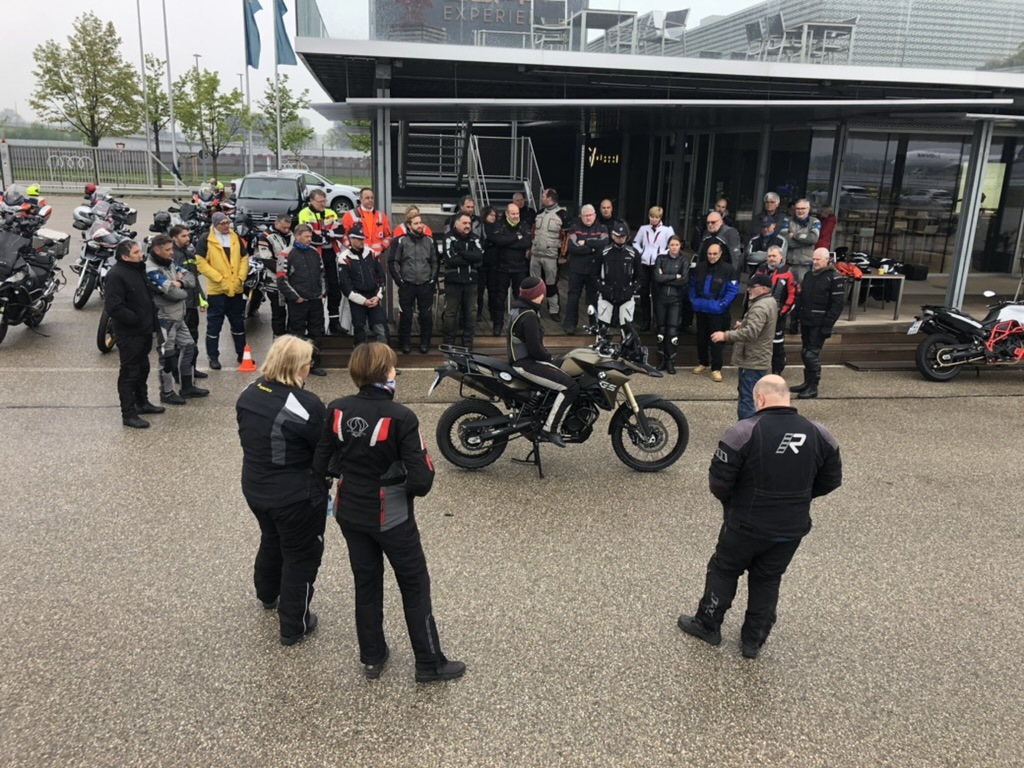On May 01.05.2022st, 1, the club attended the driving safety training course of the MfVü (Motorcycle Friends of Munich Traffic Control e. V.) for the first time on the Audi test site at Munich Airport.
23 club members were there on the dot at 8.30:10 a.m. to get fit for the new season. With light drizzle and around 9 °C, the training started punctually at 1 a.m. Before going to the driving exercises, the basics were first recalled. The correct seating position on the motorcycle was the first important point. Georg Werzinger issued the simple but memorable motto for men: "Balls to the tank!" For women: "Pubbone to the tank". This part also included the correct arm and foot position and of course what the complete personal protective equipment must be able to do. Of course, the rules of conduct were discussed during the training and we were advised that all exercises can be done, but do not have to be. Only a good biker knows his limits and knows when to stop!

Then we went to the large test track for morning exercise with Franzi for the first time. If you are well warmed up and relaxed, you will do yourself and especially your body a big favor on a long day on the bike. For the introduction, the route was driven as normal, then followed sitting with only one hand on the handlebar; standing with one hand on the handlebars; with one foot kneeling on the bench; kneeling with both feet on the bench; top to the left; top to the right; driving in the women's seat. The route was then closed again to divide us into groups of about 1 drivers.
The 5 stations for the practical part of the training were: driving in a circle and figure eight, the Zimmermann course, emergency braking and curves and ideal line course.
As with almost all exercises, driving in a circle depends on your gaze. "Looked tree, drove tree!". There were 2 circles, an inner (narrower) and an outer (larger) circle. First for 1 driver in the inner circle and 1 driver in the outer circle in the same direction, then in the opposite direction and then changing circles while flying. A plastic strip thrown in by the instructor Harry was also run over without any problems. At the end all 6 drivers drove in the circles at the same time.
In the eight with Enrico, the circle driving was intensified. In addition to visual guidance, mobility on the motorcycle is also important here. In order to make it even easier to ride aft at walking speed, training was given to work with the "bottom" in order to move the motorcycle even more easily in the desired direction by shifting your weight.
In Franzi's carpenter's course, it was really all about moving the buttocks. The course begins with a slalom; followed by a narrow marked right turn; over laid out plastic boards; into a tight left turn; over 2 inclined boards; in a circle; into a combination of a left turn with an immediate 180° right turn; ending in 4 increasingly narrow left-right curves. Here you have to be active on the bike to get through without making any mistakes.
At the emergency braking station, Schorsch first explained the individual types of braking systems to us. Which special features and what you have to pay attention to in your own case. Then it was again about the correct sitting position, arm position, foot position and “squeezing a lemon”. The first emergency braking took place at a speed of approx. 50 km/h. This was increased up to 120 km/h and those who wanted could go even further, but at around 140 km/h it was over because the available distance would no longer have been sufficient.
In the course of curves and ideal lines with Sabine and Anja, it was again about the basics: Why does a motorcycle take a curve? The correct approach to and driving through a curve was then discussed, the different techniques for driving a curve, constant driving at the same speed, regardless of whether it is a curve or a straight line, and again the movement on the motorcycle and what does my motorcycle do (load on the pegs; Popo right or left next to the seat). In this small course we really had the opportunity to try everything and get to know our motorcycle and the reactions to the riding techniques. It was particularly interesting to hear the tires singing.
The training day ended with all participants having the opportunity to drive freely on the test track. With the optimal asphalt conditions, the track was full very quickly and we were able to do our laps. At the end of the training, the instructors were also available if someone wanted to practice again at a station or to get a tip or two.
Our thanks go to all the MfVü volunteers who guided us so wonderfully on this day. We are already looking forward to our training day next year.
